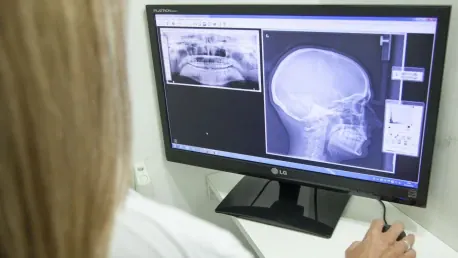The Institute of Physics (IOP) has recognized several companies for their outstanding contributions to the fields of imaging and medical physics with the prestigious IOP Business Awards 2024. Celebrating the significant advancements made by these firms across various industries, the awards highlight the innovative application of physics principles to solve real-world problems. The awards ceremony, hosted by former UK science minister David Willetts, took place at the Houses of Parliament in London.
Geoptic: Ensuring Infrastructure Safety
Cosmic-Ray Muon Radiography and Tomography
Geoptic, a spin-out from the universities of Durham, Sheffield, and St Mary’s Twickenham, has been honored with its second IOP business award. The company utilizes cosmic-ray muon radiography and tomography to inspect large engineering structures. This advanced technology allows for the non-invasive detection of hidden structural hazards, ensuring the safety of the UK’s railway tunnels. Given the historical nature and potential hazards associated with these structures, Geoptic’s work is crucial for maintaining infrastructure integrity.
This innovative method leverages cosmic-ray muons, subatomic particles that can penetrate even the densest materials. By tracking these muons, Geoptic can create detailed images of the internal structure of tunnels, identifying potential weaknesses or damage that could compromise their safety. This non-invasive technology is particularly valuable for inspecting aging infrastructure, where traditional methods might be too disruptive or simply ineffective.
Real-World Applications and Impact
Geoptic’s innovative approach offers a highly effective method for addressing the integrity of aging tunnels, benefiting Network Rail and the overall railway system in the UK. By leveraging cosmic-ray muons, the company provides a unique solution that enhances infrastructure safety without the need for invasive procedures. This technology, derived from academic research, exemplifies how cutting-edge physics can be applied to solve practical challenges in the real world.
The company’s work has already had a significant impact on the UK railway system. By providing a reliable, non-invasive way to inspect tunnels, Geoptic has helped to ensure the safety and reliability of the railway system, reducing the risk of accidents and costly repairs. This technology is not only applicable to railway tunnels but holds potential for a wide range of infrastructure projects, including bridges, dams, and other critical structures.
Silveray: Revolutionizing X-Ray Imaging
Flexible, Color X-Ray Detectors
Silveray, a company that emerged from the University of Surrey, received an IOP Business Start-up Award for its development of flexible, color X-ray detectors. These detectors, based on proprietary semiconductor materials, offer color imaging capabilities that traditional black-and-white X-rays cannot provide. Silveray’s innovation lies in the use of nano-particle semiconductor ink, which can be applied to various surfaces and function across multiple wavelengths.
The flexibility of these detectors allows them to be integrated into a variety of applications, from medical imaging to industrial inspection. The ability to produce color images adds a new dimension to X-ray imaging, making it easier to distinguish between different types of materials or tissues. This technology has the potential to revolutionize the field of X-ray imaging, providing more detailed and informative images than ever before.
Advancements in Medical Imaging
The flexible, color X-ray detectors developed by Silveray streamline the imaging process and offer real-time digital results. This advancement reduces costs and increases efficiency compared to conventional X-ray film. The ability to provide color imaging enhances diagnostic capabilities, making it easier for medical professionals to identify and analyze different tissues and structures within the body. Silveray’s technology represents a significant leap forward in medical imaging, with the potential to improve patient outcomes and reduce healthcare costs.
Silveray’s technology not only enhances the diagnostic capabilities of X-ray imaging but also simplifies the imaging process. The use of digital detectors eliminates the need for developing film, speeding up the process and reducing the environmental impact associated with traditional X-ray imaging. This technology also has the potential to be used in a variety of other applications, including security screening and industrial inspection, where the ability to produce detailed, color images can provide valuable information.
Phlux Technology: Enhancing 3D Imaging
Semiconductor Technology for Infrared Light Sensors
Phlux Technology, originating from researchers at the University of Sheffield, was honored with an IOP Business Start-up Award for its semiconductor technology for infrared light sensors. These devices boast a sensitivity twelve times greater than existing solutions, making them ideal for applications such as lidar, laser range finders, and optical-fiber test instruments. The enhanced sensitivity and resolution of these sensors present significant improvements for 3D imaging and safety systems.
The high sensitivity of Phlux’s infrared light sensors allows for more accurate and detailed 3D imaging, which is crucial for a variety of applications. In particular, these sensors are well-suited for use in autonomous vehicles, where accurate 3D imaging is essential for navigation and safety. By providing more detailed and reliable data, Phlux’s sensors can help to improve the performance of these vehicles, making them safer and more reliable.
Applications in Automotive Technology
Phlux’s highly sensitive infrared sensors are particularly beneficial for the automotive industry, where high-resolution imaging over long distances is crucial for advanced safety features. The improved sensitivity and resolution enable more accurate and reliable 3D imaging, enhancing the performance of lidar systems used in autonomous vehicles. This technology not only improves safety but also supports the development of next-generation automotive technologies, driving innovation in the industry.
The impact of Phlux’s technology extends beyond the automotive industry. These high-sensitivity sensors can be used in a variety of other applications, including industrial inspection, environmental monitoring, and security. The ability to produce detailed, high-resolution images in a wide range of conditions makes these sensors a valuable tool for a variety of industries, helping to drive innovation and improve performance.
Crainio: Non-Invasive Medical Technology
Infrared Photoplethysmography for Measuring Intracranial Pressure
Crainio, a medical technology company spun off from City, University of London, received the 2024 Lee Lucas award for its groundbreaking technology that enables non-invasive measurement of intracranial pressure (ICP). Current methods for measuring ICP are highly invasive, requiring neurosurgical intervention. Crainio’s solution uses infrared photoplethysmography (PPG), combined with machine learning, to offer a non-invasive alternative.
The technology developed by Crainio offers a safer and more efficient way to measure ICP, reducing the risks and discomfort associated with traditional methods. By using infrared light to measure blood flow in the brain, combined with advanced machine learning algorithms, Crainio’s technology can provide accurate, real-time measurements of ICP without the need for invasive procedures. This innovation has the potential to transform the way ICP is measured and managed, improving patient outcomes and reducing the burden on healthcare systems.
Impact on Healthcare
Crainio’s technology can be deployed quickly in emergency scenarios, potentially saving lives and reducing risks associated with invasive procedures. The non-invasive measurement of ICP is a critical advancement in healthcare, providing a safer and more efficient method for monitoring patients with conditions that affect intracranial pressure. This innovation has the potential to transform the way healthcare professionals manage and treat such conditions, improving patient outcomes and reducing the burden on healthcare systems.
The ability to quickly and accurately measure ICP without invasive procedures is particularly valuable in emergency situations, where time is of the essence. Crainio’s technology can be used to quickly assess patients with head injuries or other conditions that affect intracranial pressure, allowing healthcare professionals to make timely and informed decisions about treatment. This technology has the potential to save lives and improve outcomes for a wide range of patients, providing a valuable tool for healthcare providers.
The Role of Physics in Technological Innovation
Transforming Research into Commercial Solutions
The IOP business awards spotlight the critical role of physics in fostering technological innovations that have broad, real-world applications. Each award-winning company has identified a specific problem within its domain and applied a unique physics-based solution to address it. This approach underscores the versatility and applicability of physics, demonstrating the field’s potential to drive technological advancements and improve lives.
The success of these companies highlights the importance of continued investment in physics-based research. By supporting fundamental research and encouraging the translation of this research into practical solutions, we can drive innovation and address some of the most pressing challenges facing our world today. The achievements of these award-winning firms demonstrate the transformative power of physics, providing a blueprint for how to harness this power to create a better future.
Encouraging Continued Investment in Physics-Based Research
The Institute of Physics (IOP) has honored a number of companies with the prestigious IOP Business Awards 2024 for their groundbreaking contributions in the fields of imaging and medical physics. These renowned awards celebrate the substantial progress that these firms have achieved across various industries, showcasing how they have innovatively applied physics principles to address and solve real-world challenges. The event drew significant attention, underscoring the importance of physics in contemporary technological and medical advancements.
Hosted by the former UK science minister David Willetts, the awards ceremony took place at the historic Houses of Parliament in London. This prestigious location added to the ceremony’s grandeur, reflecting the high regard in which these awards are held. The winners, through their innovative work, exemplify how physics can be leveraged to improve lives and industries. Their recognized achievements serve not only as a testament to their hard work and ingenuity but also as an inspiration for future breakthroughs in the application of physics principles to solve everyday problems.









